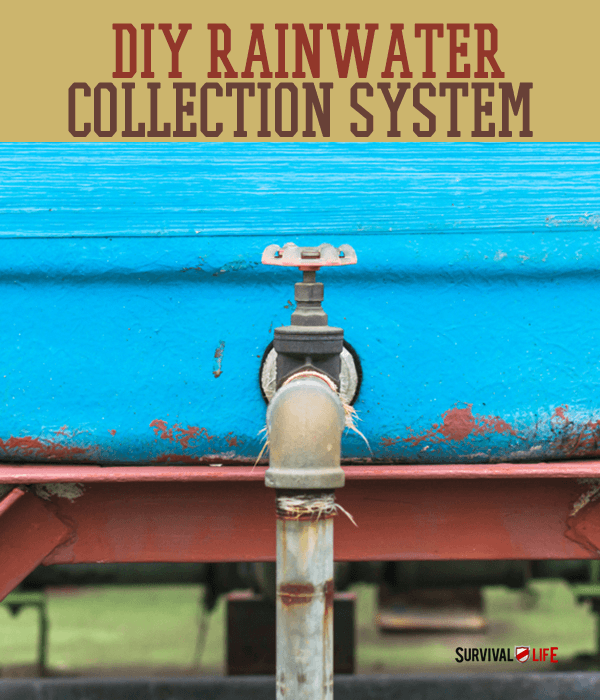Do It Yourself
DIY Rainwater Collection System

Rainwater collection is a great way to reduce your water usage. Did you know the average person wastes about 30 gallons of water per day? Holy moly! Just imagine if you could save at least a third of your water usage. Well, you can! A rainwater collection system is a really great way to recycle water during those hot summer months when water conservation is at its most necessary!
However, exercise caution. Some states enforce strict rainwater harvesting regulations. In Colorado, for example, collecting rainwater is illegal, as it is public property and belongs to the Colorado water table. Those who collect this water are diminishing the supply for agriculture. See more about rainwater regulations here.
Rainwater collection has been practiced for centuries. The growing movement for DIY water conservation only confirms our need to recycle our natural resources and replenish our own depleting supply. This step-by-step tutorial will get you started on your DIY rainwater collection system:
Materials:
- Paint strainer
- 5 gallon bucket
- 55 gallon drum with lid
- Downspout fittings
- Gutter strainer
- Cinder blocks (3)
- 3/4″ spigot with 1/4″ turn ball valve
- Permanent black marker
- Jigsaw
- Power drill with 7/8″ spade bit
- Half-round bastard file
- Utility knife
- 1 1’4″ galvanized wood screws
Step 1: With the 7/8″ spade bit, drill a starter hole in the side of the 5 gallon bucket. Use your jigsaw to cut around the bucket.
Step 2: Using your permanent marker, trace the top of the 5 gallon bucket on top of the 55 gallon drum.
Step 3: Just like you did with the top of the 5 gallon bucket, drill a hole in the top of the drum with your 7/8″ spade bit to get you started. Following the guideline you created with the permanent marker, cut out the circle with the jigsaw.
The top of the 5 gallon bucket should fit snug in the opening of the 55 gallon drum.
Step 4: Drill a hole at the bottom side of the drum with the 7/8″ spade bit. File down the inside of the hole with your half-round bastard file. Screw in your 3/4″ spigot until it fits securely. It may need to be filed a little more to fit just right.
Step 5: Prop the cinder blocks upright in a triangle manner next to the house. Place your drum on top of the cinder blocks.
Step 6: Using the existing downspout from your gutters, add an extension to run down into the rainwater collection. Measure and mark where you need to cut the fitting so that the end will run into the top of your collection barrel.
Cut the extension with a utility knife and fit to existing downspout.
Use brackets to secure the fittings to the side of the house.
Step 7: Trace the end of the downspout on the lid of the 5 gallon bucket. This will keep large objects from falling into the collection system.
Use the 7/8″ spade bit to drill starter holes.
Cut the remainder of your lid with the jigsaw.
Place the lid back on top of the bucket to check for a proper fit.
Step 8: Standing water can be a haven for mosquitoes, so we want to keep them out of the rain barrel.
Tie a knot in the paint strainer and secure to the top of the bucket.
Step 9: Place a gutter strainer in the opening of the gutter on the roof. This will keep large debris from making its way down the fittings and potentially clogging the gutters.
This rainwater collection system will be up and running in no time. Even your little ones will enjoy it!
Check out the step-by-step video tutorial:
Check out more DIY tutorials:
DIY Garden Design | Grow 100 Pounds Of Potatoes
Like this post?
Be sure to like us on Facebook so you can be the first to know about latest survival tips and off the grid living skills.
-

 Do It Yourself7 months ago
Do It Yourself7 months agoParacord Projects | 36 Cool Paracord Ideas For Your Paracord Survival Projects
-

 Do It Yourself9 months ago
Do It Yourself9 months agoHow To Make Paracord Survival Bracelets | DIY Survival Prepping
-

 Do It Yourself9 months ago
Do It Yourself9 months ago21 Home Remedies For Toothache Pain Relief
-

 Do It Yourself10 months ago
Do It Yourself10 months agoSurvival DIY: How To Melt Aluminum Cans For Casting
-

 Exports8 months ago
Exports8 months agoAre Switchblades Legal? Knife Laws By State









Michael W. Perry
June 5, 2014 at 3:15 PM
Quote: ” In Colorado, for example, collecting rainwater is illegal, as it is public property and belongs to the Colorado water table.”
Colorado is joining California as an intrusive, meddlesome ‘must not live there’ state.
Most uses of rainwater (i.e. gardens) put that rainwater back into the ground. They merely move that time from the rainy season, when it is not needed, to the dry season, when it is.
alain smithee
June 7, 2014 at 4:15 PM
This sounds like a bureaucratic way of forcing you to pay the water utility and pad their profits.
That’s OK – I’m sure that I can use PVC pipe to create a hidden storage system disguised as a leach field and solar powered pumps so that it looks like I’m using city water for my garden without subsidizing a local government and their nepotistic practices.
mixplix
June 6, 2014 at 6:56 PM
Bed sheets and Thompson Water Seal will make very inexpensive water proof fabrics useful in catching water or protecting you from it.
mixplix
June 6, 2014 at 7:01 PM
I’m trying to put together a video the way to heist a person that’s wounded or hurt with a rope. What knot is used? How is it applied? To lift someone up a number of feet?
rob leech
June 22, 2014 at 3:00 PM
get a cheap piece of 12′ webbing and make a harness to lift the person
Pingback: 7 Off-grid Projects for Survivalists
Pingback: 13 Everyday Items For Survival - Survival Life | Preppers | Survival Gear | Blog - Survival Life | Preppers | Survival Gear | Blog
Pingback: DIY Projects | How to Make a Spotlight Out of a Flashlight - Survival Life | Preppers | Survival Gear | Blog
Pingback: Disaster Preparedness | Camping In The Rain
Pingback: Camping In The Rain – Zombie Emergency Response Group (ZERG)
Pingback: Do Chemical Water Purification Methods Really Work? | Survival Life
Pingback: 12 Rainwater Collection Tips | Survival Life
Pingback: The Many Uses for Shipping Containers | Survival DIY Ideas
Pingback: The Benefits of Camping In The Rain | Survival Life
Pingback: How Does Chemical Water Purification Work | Survival Life
Pingback: Everyday Items That are Helpful During the Apocalypse | Survival Life
Pingback: 13 Everyday Items You Could Use For Survival – Preppers Info
Pingback: 13 Everyday Items You Could Use For Survival - Survive!
Chet Smith
June 3, 2018 at 9:40 AM
This is what I have been looking for. Thank you for sending this out so some of us do-it yourself types could have a rainwater collection system for our garden.
Pingback: 7 Off-Grid Projects for Survivalists - OffGridHub